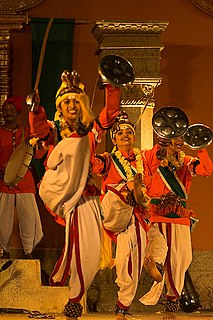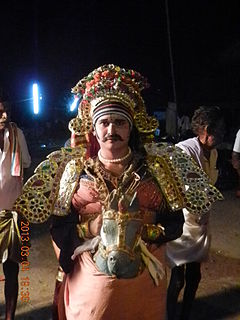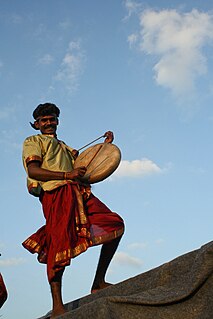
Dance is a performing art form consisting of purposefully selected sequences of human movement. This movement has aesthetic and symbolic value, and is acknowledged as dance by performers and observers within a particular culture. Dance can be categorized and described by its choreography, by its repertoire of movements, or by its historical period or place of origin.

Japanese traditional dance has a long history, the oldest known ones may be among those transmitted through the kagura tradition, or folk dances relating to food producing activities such as planting rice (dengaku) and fishing, including rain dances. There are large number of these traditional dances, which are often subfixed -odori, -asobi, and -mai, and may be specific to a region or village. Mai and Odori are the two main groups of Japanese dances, and the term Buyō (舞踊) was coined in modern times as a general term for dance, by combining mai and odori.

Dance in India comprises numerous styles of dances, generally classified as classical or folk. As with other aspects of Indian culture, different forms of dances originated in different parts of India, developed according to the local traditions and also imbibed elements from other parts of the country.

The culture of Kerala is a synthesis of Aryan and Dravidian cultures, developed and mixed for centuries, under influences from other parts of India and abroad. It is defined by its antiquity and the organic continuity sustained by the Malayali people. Modern Kerala society took shape owing to migrations from different parts of India and abroad throughout Classical Antiquity.

The traditional Georgian dance was born at the intersection of two cultural worlds, the European and the Asian. Despite successive invasions, Mongolian, Persian, Ottoman and Russian, it has retained its own characteristics.
Kalbelia or Kabeliya is a dance from Rajasthan, performed by the tribe of the same name. The dance is an integral part of their culture and performed by men and women.
Karnataka has a variety of traditional arts, including folk dance and puppetry.

Veeragaseವೀರಗಾಸೆ is a dance form prevalent in the state of Karnataka, India. It is a vigorous dance based on Hindu mythology and involves very intense energy-sapping dance movements performed by Jangama. Veeragase is one of the dances demonstrated in the Dasara procession held in Mysore. This dance is performed during festivals and mainly in the Hindu months of Shravana and Karthika. It is performed at all important functions of Lingayat household.
Himachali dance forms are highly varied and quite complicated. These dances are very vital part of the tribal life. It reflects the culture and the tradition of Himachal. Hardly any festivity here is celebrated without dancing. Some of the dance forms like Nati (dance) are danced all over the region.

The urumi is a double-headed hourglass-shaped drum from the state of Tamil Nadu, South India. Two skin heads are attached to a single hollow, often intricately carved wooden shell. The preferred wood is jackwood, although other woods like rosewood may be used. Both left and right heads are usually made from cow hide that is stretched around a thin metal ring. The outer circumference of each head is perforated with approximately seven to eight holes. The two heads are held in tension by a continuous rope that is woven around the drum in a V-shape pattern. Additional small coils of string or metal are tied around each pair of ropes near the left head. These coils can be slide horizontally along the length of the drum, increasing or decreasing the tension between the heads as necessary. For example, during the monsoon season the drum heads will slacken so much that the instrument becomes unplayable. Using these coils drummers can easily rectify such problems.
Tamil Nadu has a rich history of art of entertainment. The three modes of entertainment classified as Iyal (Literature), Isai (Music) and Nadagam (Drama) had their roots in the rural folk theatre like Theru Koothu. Many forms of group and individual dances with the classical forms for popularity and sheer entertainment value. Some of the dance forms are performed by Tribal people. The majority of these dances are still thriving in Tamil Nadu today.
Puliyattam is an old folk art dance of Tamil country. A highly exuberant and cultural festival, this dance form usually comprises a troupe of 6 performers aping the movements of the majestic, predatory tigers. Their bodies are painted by the painstaking efforts of local artists in vibrant yellow and black to resemble an exact replica of a tiger. The paintings include the ferocious looking fangs and convincing headgear replete with ears paws with claws and a long tail that conjures an accurate picture of the savage beast’s graceful movements.
'Devarattam is a folk dance performed by the Rajakambalathu Nayakkar community of Tamil Nadu; the dance is performed in a straight alignment in south and eastern part of Tamil Nadu state, South India. The dance involves fast and fluent movements according to the rhythmic sound of the deva thaththubi, an hour-glass shaped drum that is struck on one side and rubbed on the other side with a curved stick.
Sevaiattam or Servaiattam is a traditional dance performed by villagers in Tamil Nadu, in the southern part of India.

The peacock dance or peafowl dance is a traditional Asian folk dance that describes the beauty and the movement of peacock. There are several peacock dance traditions developed in Asia, among others are peacock dances of Myanmar, and in the western and northern parts of Cambodia, West Java in Indonesia, also peacock dances of Indian subcontinent in Southern India, Sri Lanka, and Bangladesh.

Poikkaal Kuthirai Aatam or Puravi Aattam is one of the folk dances of Tamil Nadu. It is a type of dance performed with a dummy horse having a gap inside so that a person can fit into it to perform the dance.

Parai Attam is a special type of dance in Tamil culture in which folks beat parai and dance to its rhythm. This is one of the oldest traditional dance. In olden days, parai was used for multiple reasons, ranging from warning people about the upcoming war, requesting the civilians to leave the battlefield, announcing victory or defeat, stopping a breach of water body, gathering farmers for farming activities, warning the wild animals about people's presence, during festivals, wedding, celebrations, worship of nature and so on. Parai Attam has been an instrumental part of all the celebrations in Tamil culture.












